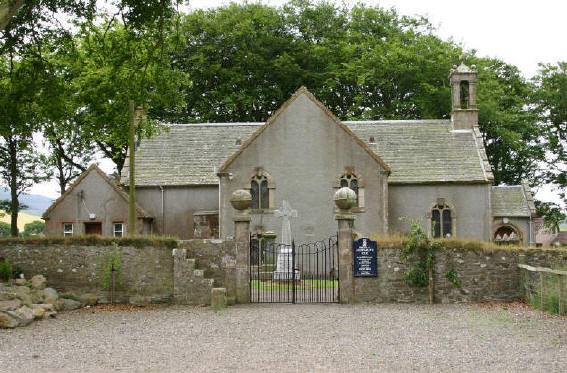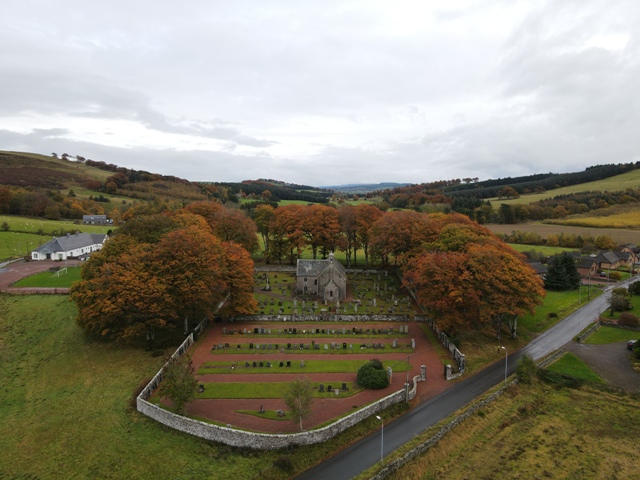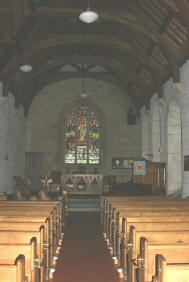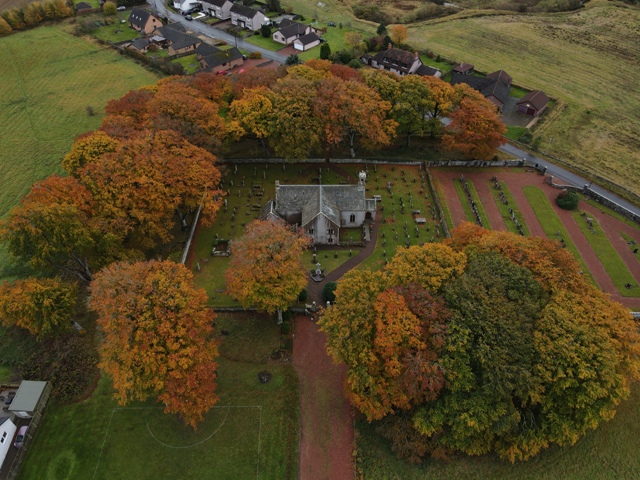

CAIRNGRYFFE PARISH CHURCH
(Previously known as Carmichael Parish Church)
“The Little Cathedral of the Upper Ward”


Its Origins
Carmichael Church was founded at the beginning of the 12th Century and was connected at this time with the see of Glasgow. The site was not the present one, but lay approximately a mile south-east of the modern building, on a hill still known as Kirkhill, within the Carmichael Estate. This early church was dedicated to St Michael.
Early in the reign of Robert Bruce (1306 – 1329) the King granted the right of patronage of Carmichael parish to the Douglases, a highly influential Scottish magnate family. The Douglas Earls retained this right until four hundred years later when it passed to the Carmichael family.
At the site of the present church two reminders exist of the former structure of Kirkhill. The outside stone stair leading to the “Carmichael loft” is pre-Reformation, and was transported from the former church. In addition to this, many old and interesting gravestones can be found in the Kirkyard which pre-date the present building; these also were brought from the old site at Kirkhill.
![]()
The Present Building
 The
church was built in 1750. At this time, it had three
galleries; the present central one for the Carmichael family; one at the
right-end of the church for the people of Drumalbin; and one at the opposite
end for the Carmichaels of Eastend. The two latter galleries were reached by
inside wooden staircases. The pulpit was in the same place as it is today and
there were also two boxes, one for the Manse and one for the people of Westmains.
The
church was built in 1750. At this time, it had three
galleries; the present central one for the Carmichael family; one at the
right-end of the church for the people of Drumalbin; and one at the opposite
end for the Carmichaels of Eastend. The two latter galleries were reached by
inside wooden staircases. The pulpit was in the same place as it is today and
there were also two boxes, one for the Manse and one for the people of Westmains.
In the mid-17th Century a bell was cast at the Iron Foundry at Carmichael Mill and presented to the Kirk by Sir Damill Carmichael. At the end of the 19th Century however this bell developed a crack and had to be re-cast in Glasgow. The communion vessels and tokens are of great interest. The pewter communion vessels date from 1705 and the silver cups, which are now held in the bank, bear the inscription “For the Kirk of Carmichael – 1705". The old communion tokens take two forms, one dating from 1748 and the other from 1824. The dates and name of the Church can clearly be read.
In 1904 the Church was extensively renovated according to plans by Sir John Lorimer, brother of the famous Scots Arts and Crafts architect Sir Robert Lorimer, who designed the Scot’s Memorial at Edinburgh Castle. This was brought about by the trustees of Sir Windham Robert Carmichael Anstruther who died in 1903 aged 26. Among other things, two of the lofts were removed and the Carmichael gallery was made smaller. In place of the eastern gallery a magnificent window was installed as a memorial to Sir Windham Carmichael. This window contains much of interest. Among the detail we can see the figures of Noah and Columba, to name but two, and the Coat of Arms of Glasgow, a reminder of the time when the Church was attached to the see of Glasgow. Other windows along the south wall of the Church depict Faith, Hope, Charity, Justice, Truth and Peace.
The close connection this church has had for so long with the Carmichael family is very evident. All round the church are brasses and tablets to its members, the most striking being the marble slab narrating the influential career of John Carmichael, Third Earl of Hyndford.
In 1998 a fourth window on the south wall was donated by the late Mr. & Mrs. James Warnock in celebration of their Golden Wedding and 50 years as farmers in Sandilands
Other Interesting Details
When the old seat reservations at each pew were examined, several could be seen to have borne the name Douglas. These cards extended an invitation to all who lived on Douglas lands to occupy them, for at a time when many churches demanded seat rentals, Carmichael pews were free. Other cards bore the names of local farms, and the pew at the very back was marked “Headmaster” – did he sit there to keep an eye on the congregation ?
At the gateway to the church a stone stair and a loupin’-on stane can be seen. The stone, for mounting and dismounting a horse, was used by ladies who usually rode on a pad behind their husband or servant.
In 1706 the parishioners of Carmichael petitioned against the articles of the union with England, despite the fact that their patron, the Earl of Hyndford, was heavily involved in negotiations in favour of the union.
In 1914 a group of women suffragettes broke into the Church and attempted to set it on fire. Beyond some scorching of the gallery carving no structural damage was done however and the Church is believed to have been saved by its hard oak furnishings. The Kirk Session entry recording this event reads as follows :-
“8th July 1914. The Kirk Session offer to Almighty God their heartfelt thanks for the preservation of their dear and beautiful Church from destruction by fire on a night between Sunday28th June and 1st July, 1914. Some person or persons unknown entered the Church by breaking the vestry window and piled chairs, bibles etc on the pews underneath the Carmichael gallery and, after sprinkling these with inflammable material, set fire to them. The damage was trifling considering what might have been done if the flames had taken hold of Carmichael gallery. The Kirk Session are grieved that any person could have allowed such sacrilegious intentions to enter into his or her heart.”
Linkages and Unions
In 1952, during the ministry of Rev. Wm. Cumming, Carmichael parish was linked with the neighbouring parish of Pettinain, the minister taking services in both churches. Later, in the 1970's, the adjoining parish of Covington was brought into the linkage. The minister, Rev. Jas. McKenzie, taking services in all three churches.
When a vacancy arose in 1994, the Church of Scotland decided that, due to dwindling congregations, the three parishes should be united and two of the churches closed. Initially Pettinain and Carmichael were to be closed, but following an appeal from Carmichael members the decision was reversed and Covington was closed. The united parish was renamed Cairngryffe and was linked with Symington, services now being held in Cairngryffe and Symington kirks.
In 2012, as part of a new Presbytery Plan, it was proposed that the linked charge be further linked with the Parish of Libberton & Quothquan. The three congregations overwhelmingly agreed to this arrangement and the new linkage came into effect on 1st January 2013. At the same time permission was granted for the three congregations to call a new Minister, a locum being appointed during the vacancy. Services continued in all three churches, the minister/locum taking two of them with the third congregation responsible for providing worship in their church.
On 16th January 2014 Rev George C. Shand, formerly of St Andrew Church of Scotland, Jerusalem, was inducted as the new minister of the triple linkage. He retired on 31st July 2021.

Graveyard
A booklet containing a list of all the graves in the Churchyard is available from the Lanarkshire Family History Society .